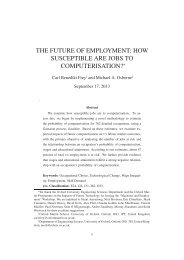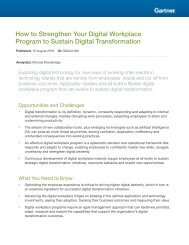THE FUTURE OF EMPLOYMENT: HOW SUSCEPTIBLE ARE JOBS TO COMPUTERIZATION?
We examine how susceptible jobs are to computerization. To assess this, we begin by implementing a novel methodology to estimate the probability of computerization for 702 detailed occupations, using a Gaussian process classifier. Based on these estimates, we examine expected impacts of future computerization on US labor market outcomes, with the primary objective of analyzing the number of jobs at risk and the relationship between an occupation’s probability of computerization, wages and educational attainment. According to our estimates, about 47 percent of total US employment is at risk. We further provide evidence that wages and educational attainment exhibit a strong negative relationship with an occupation’s probability of computerization.
We examine how susceptible jobs are to computerization. To assess this, we begin by implementing a novel methodology to estimate the probability of computerization for 702 detailed occupations, using a Gaussian process classifier. Based on these estimates, we examine expected impacts of future computerization on US labor market outcomes, with the primary objective of analyzing the number of jobs at risk and the relationship between an occupation’s probability of computerization, wages and educational attainment. According to our estimates, about 47 percent of total US employment is at risk. We further provide evidence that wages and educational attainment exhibit a strong negative relationship with an occupation’s probability of computerization.
You also want an ePaper? Increase the reach of your titles
YUMPU automatically turns print PDFs into web optimized ePapers that Google loves.
TABLE II. Performance of various classifiers; best performances in bold.<br />
classifier model AUC log-likelihood<br />
exponentiated quadratic 0.894 −163.3<br />
rational quadratic 0.893 −163.7<br />
linear (logit regression) 0.827 −205.0<br />
ing characteristic curve (AUC), which is equal to one for a perfect classifier,<br />
and one half for a completely random classifier, and the log-likelihood, which<br />
should ideally be high. This experiment was repeated for one hundred random<br />
selections of training set, and the average results tabulated in Table II. The<br />
exponentiated quadratic model returns (narrowly) the best performance of the<br />
three (clearly outperforming the linear model corresponding to logistic regression),<br />
and was hence selected for the remainder of our testing. Note that its<br />
AUC score of nearly 0.9 represents accurate classification: our algorithm successfully<br />
managed to reproduce our hand-labels specifying whether an occupation<br />
was computerisable. This means that our algorithm verified that our subjective<br />
judgements were systematically and consistently related to the O∗NET<br />
variables.<br />
Having validated our approach, we proceed to use classification to predict<br />
the probability of computerisation for all 702 occupations. For this purpose,<br />
we introduce a new label variable, z, denoting whether an occupation is truly<br />
computerisable or not: note that this can be judged only once an occupation<br />
is computerised, at some indeterminate point in the future. We take, again, a<br />
logistic likelihood,<br />
(8) P(z ∗ = 1 | f ∗ ) =<br />
1<br />
1+exp(−f ∗ ) .<br />
We implicitly assumed that our hand label, y, is a noise-corrupted version of<br />
the unknown true label, z. Our motivation is that our hand-labels of computerisability<br />
must necessarily be treated as such noisy measurements. We thus<br />
acknowledge that it is by no means certain that a job is computerisable given<br />
our labelling. We define X ∗ ∈ R 702×9 as the matrix of O∗NET variables for all<br />
702 occupations; this matrix represents our test features.<br />
We perform a final experiment in which, given training data D, consisting<br />
34





